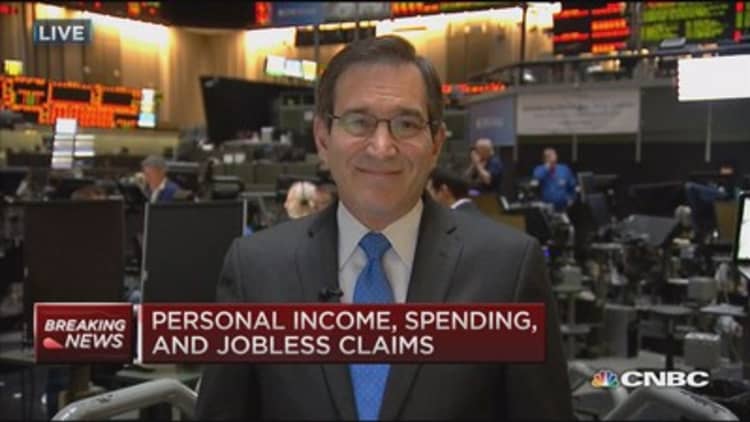
The number of Americans filing new claims for unemployment benefits last week dropped to the lowest level since 2000, suggesting March's moderation in job growth was likely an aberration. Meanwhile, U.S. labor costs rose solidly in the first quarter as wages in the private sector increased, which could keep the Federal Reserve on track to raise interest rates this year.
In a separate report, U.S. consumer spending rose in March as households stepped up purchases of durable goods, suggesting the economy was regaining some momentum after almost screeching to a halt in the first quarter.
Initial claims for state unemployment benefits declined 34,000 to a seasonally adjusted 262,000 for the week ended April 25, the lowest reading since April 2000, the Labor Department said on Thursday.
Read MoreHow millennials could damage the US economy
Claims for the prior week were revised to show 1,000 more claims received than previously reported. It was the eighth straight month that claims remained below 300,000, which is usually associated with a strengthening labor market.
Economists polled by Reuters had forecast claims falling to 290,000 last week.
A Labor Department analyst said the government had estimated claims for Louisiana because of a power outage in the state. This, however, had little impact on the claims data as the estimate was close to the figure that Louisiana later provided.
The four-week moving average of claims, considered a better measure of labor market trends as it irons out week-to-week volatility, fell 1,250 last week to 283,750.
The number of people still receiving benefits after an initial week of aid dropped 74,000 to 2.25 million in the week ended April 18.
The so-called continuing claims covered the period during which the government surveyed households for April's unemployment rate. Continuing claims declined 160,000 between the March and April survey periods, suggesting an improvement in the jobless rate from 5.5 percent in March.
US labor costs rise solidly; wage growth picks up
The Employment Cost Index, the broadest measure of labor costs, advanced 0.7 percent—the largest gain since the third quarter of 2014—after an unrevised 0.5 percent rise in the fourth quarter, the Labor Department said on Thursday.
Economists polled by Reuters had forecast the employment cost index rising 0.6 percent in the January-March period.
The ECI is widely viewed by policymakers and economists as one of the better measures of labor market slack.
Unlike the average hourly earnings (AHE) measure in the employment report, the ECI covers a broad range of workers and is weighted to eliminate composition effects, which economists say have distorted the AHE.
Read MoreAmericans want to save, but fall short
The ECI is seen as a better predictor of core inflation.
Wages and salaries, which account for 70 percent of employment costs, rose 0.7 percent in the first quarter. They had increased 0.6 percent in the fourth quarter.
Private sector wages and salaries increased 0.7 percent, the largest rise since the third quarter of 2014, after gaining 0.5 percent in the prior quarter.
In the 12 months through March, labor costs jumped 2.6 percent, the largest rise since the fourth quarter of 2008. That is still below the 3 percent threshold that economists say is needed to bring inflation closer to the Fed's 2 percent target.
Labor costs increased 2.2 percent in the 12 months through December.
Private sector wages and salaries were up 2.8 percent in the 12 months through March, the biggest gain since the third quarter of 2008, after rising 2.2 percent in the 12 months through December.
Benefit costs increased 0.6 percent in the first quarter. They increased 2.7 percent in the 12 months through March after rising 2.6 percent in the 12 months through December.
US consumer spending picks up, but income flat
The Commerce Department said on Thursday that consumer spending increased 0.4 percent last month after rising 0.2 percent in February. While households increased purchases of big-ticket items like automobiles, warmer weather reduced spending on utilities.
Economists polled by Reuters had forecast consumer spending, which accounts for more than two-thirds of U.S. economic activity, increasing 0.5 percent last month.
Read MoreWant more for your money? Vacation here
When adjusted for inflation, consumer spending rose 0.3 percent in March after being flat in the prior month.
The data were included in Wednesday's first-quarter gross domestic product snapshot, which showed the economy growing at only a 0.2 percent annual pace after a 2.2 percent rate in the fourth quarter.
The economy slowed to a crawl as it struggled with severe winter weather, a now-settled labor dispute at normally busy West Coast ports, a strong dollar and lower energy prices, which have cut into domestic oil production.
The Federal Reserve on Wednesday acknowledged the first quarter's sharp growth moderation, but dismissed it as partly the result of transitory factors.
Read MoreHold onto your stocks or sell now?
Spending last month picked up despite personal income being flat. While savings slipped, they remained at lofty levels, which should fuel future consumer spending.
Inflation pressures remained benign. A price index for consumer spending increased 0.2 percent after a similar gain in February. In the 12 months through March, the personal consumption expenditures (PCE) price index rose 0.3 percent.
Excluding food and energy, prices rose 0.1 percent for a third straight month. The so-called core PCE price index increased 1.3 percent in the 12 months through March.

